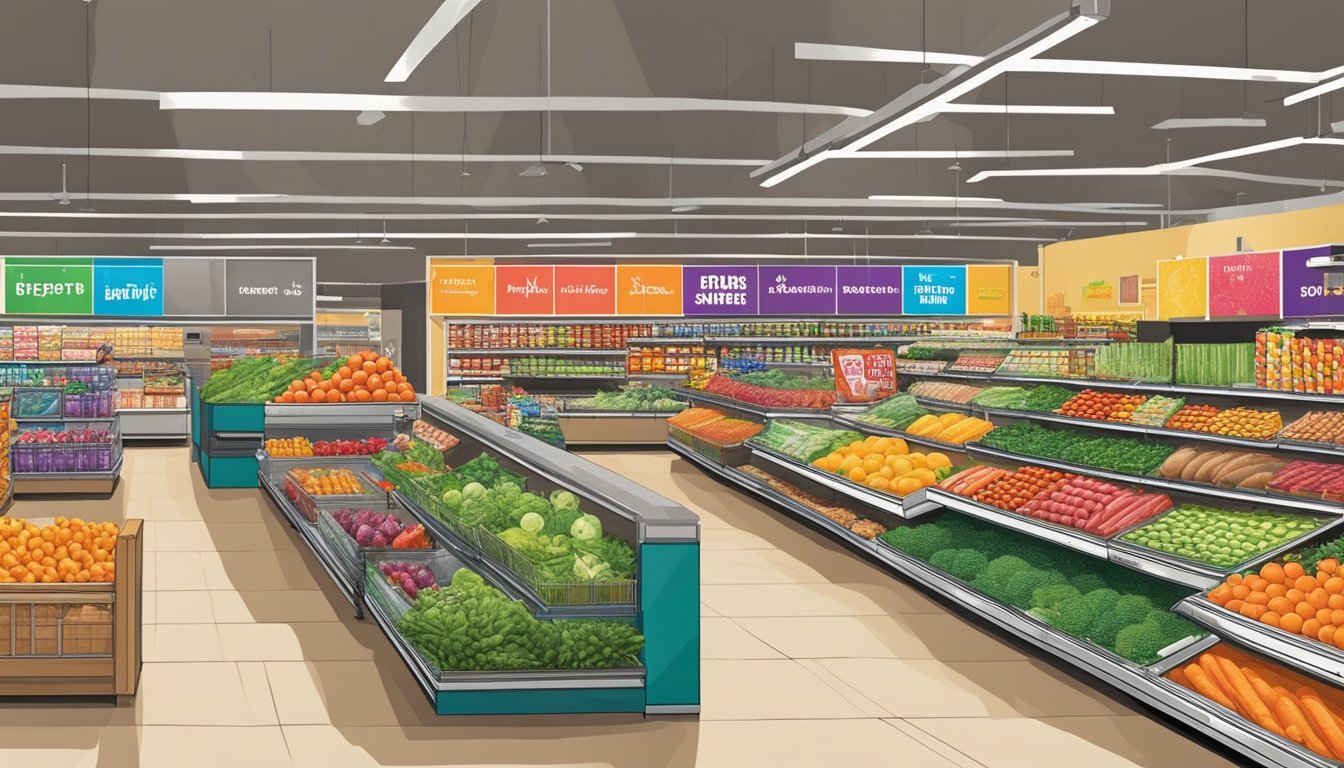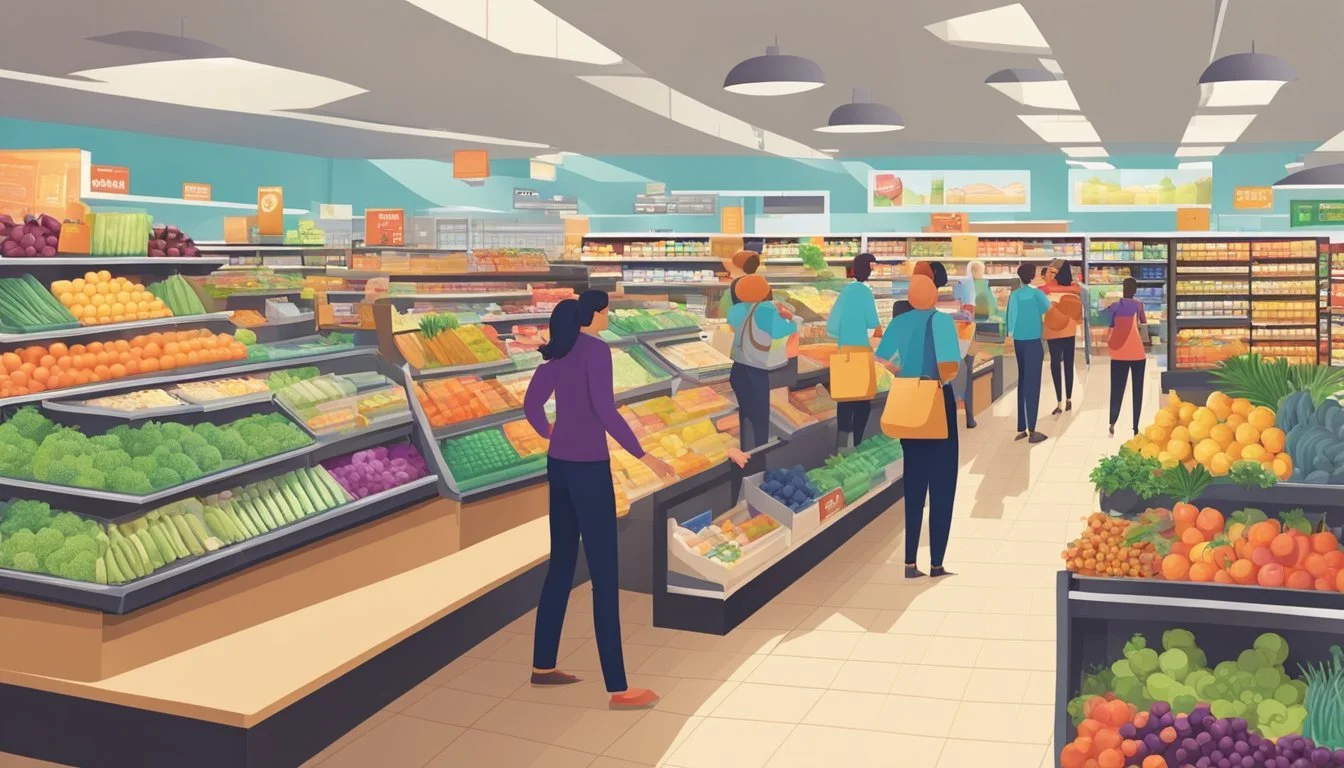Brookshire Grocery Company vs Five Below
Comparing Value and Selection in Retail Chains
Brookshire Grocery Company and Five Below are two distinct retail chains with different focuses. Brookshire's operates over 200 grocery stores across Texas, Louisiana, and Arkansas, offering a wide range of food products and household essentials. Five Below, on the other hand, is a discount store chain specializing in products priced at $5 or less, including toys, games, and accessories.
In terms of grocery shopping, Brookshire Grocery Company is the better option as it offers a full range of food products and fresh produce, while Five Below does not primarily focus on groceries. Brookshire's has been serving communities for over 95 years, building a reputation for customer service, clean stores, and fresh products.
While both companies have their strengths, comparing them directly as grocery stores is not entirely appropriate. Brookshire's caters to comprehensive grocery needs, while Five Below targets budget-conscious shoppers looking for affordable non-grocery items. The choice between the two depends on the specific shopping needs of the customer.
Company Overviews
Brookshire Grocery Co. and Five Below are distinct retail entities with unique histories and business models. Both companies have carved out successful niches in their respective markets.
Brookshire Grocery Company History
Brookshire Grocery Co. traces its roots to Tyler, Texas in 1928. Founded by Wood T. and Louise Brookshire, the company began with a single 25 x 100-foot store on Tyler's downtown square.
The family-owned business expanded steadily over the decades. Today, Brookshire Grocery Co. operates more than 200 supermarkets across Texas, Louisiana, Arkansas, and Oklahoma.
Known for its commitment to customer service, Brookshire's has maintained its family ownership structure. The company's growth strategy has included both organic expansion and strategic acquisitions.
Five Below Profile
Five Below, founded in 2002, is a rapidly growing specialty discount chain. The company targets teens and pre-teens with a wide array of products priced at $5 or less.
Headquartered in Philadelphia, Five Below has expanded to over 1,000 stores across the United States. The retailer's concept revolves around offering trendy, seasonal items at affordable prices.
Five Below's product range includes tech accessories, room decor, clothing, and candy. The company's success stems from its ability to quickly adapt to changing trends and maintain attractive price points.
Unlike Brookshire's focus on groceries, Five Below operates in the discretionary retail sector. This distinction shapes their respective business strategies and target markets.
Store Offerings Comparison
Brookshire Grocery Company and Five Below have distinct product assortments and specialties that cater to different customer needs. Their offerings vary significantly in terms of grocery selection, fresh produce, and specialty items.
Product Assortment and Brands
Brookshire Grocery Company provides a wide range of grocery products, including national brands and their own Food Club private label. They stock everything from pantry staples to frozen foods and household essentials.
Five Below, on the other hand, focuses on offering trendy, affordable items priced at $5 or less. Their product mix includes snacks, candy, and drinks, but lacks a full grocery selection.
Brookshire's carries popular brands like Kraft, Coca-Cola, and Kellogg's alongside their private label offerings. Five Below primarily stocks lesser-known brands and novelty items in their limited food section.
Produce and Meat Quality
Brookshire Grocery Company emphasizes fresh produce and meats in their stores. They offer a variety of fruits, vegetables, and cuts of meat sourced from local and national suppliers.
Their produce departments feature seasonal items and staple fruits and vegetables. The meat counters provide fresh cuts of beef, pork, and poultry, as well as seafood options in many locations.
Five Below does not have dedicated produce or meat departments. Their food offerings are limited to packaged snacks, candies, and shelf-stable items. Fresh produce and meats are not available at Five Below stores.
Organic and Specialty Items
Brookshire Grocery Company has expanded its organic and specialty food offerings in recent years. They stock organic produce, meats, and packaged goods to cater to health-conscious consumers.
Their Goldenbrook Farms private label includes organic dairy products. Specialty items like gluten-free options, international foods, and gourmet ingredients are also available in many Brookshire's stores.
Five Below does not focus on organic or specialty grocery items. Their food selection is primarily composed of mainstream snacks and candies, with limited healthy or specialty options.
Pricing and Value
Brookshire Grocery Company and Five Below employ distinct pricing strategies to attract customers. Their approaches to everyday prices, sales, and reward programs shape the value proposition for shoppers.
Everyday Prices and Sales
Brookshire Grocery Company offers competitive prices on groceries and household essentials. They frequently run weekly sales and promotions on popular items. Seasonal discounts and holiday specials provide additional savings opportunities.
Five Below, in contrast, maintains a consistent $5-or-less price point on most items. This simplified pricing model appeals to budget-conscious shoppers seeking affordable non-grocery products.
Walmart often undercuts both retailers on similar grocery items. Albertsons competes more directly with Brookshire's pricing structure in overlapping markets.
Membership and Reward Programs
Brookshire's Thank You Card program rewards loyal customers with personalized deals and fuel discounts. Members earn points on purchases, redeemable for grocery savings.
Five Below lacks a formal loyalty program. Instead, they offer a flat low-price guarantee across their inventory.
Walmart's Walmart+ membership provides free delivery and other perks for a monthly fee. Albertsons' Just for U program offers digital coupons and personalized deals similar to Brookshire's approach.
Customer Experience
Brookshire Grocery Company and Five Below offer distinct customer experiences tailored to their target markets. Both prioritize customer satisfaction but implement different strategies to achieve it.
Store Layout and Accessibility
Brookshire Grocery Company focuses on a traditional grocery store layout. Aisles are organized by product categories, making it easy for customers to find what they need. The stores typically feature wide aisles to accommodate shopping carts and provide ample space for browsing.
Five Below, in contrast, employs a more dynamic layout. The store is divided into themed sections, often with eye-catching displays. Products are arranged to encourage exploration and impulse purchases. This layout can be more engaging but potentially less intuitive for quick shopping trips.
Both retailers strive for accessibility, with clear signage and well-lit spaces. Brookshire tends to have more spacious parking lots, catering to larger grocery trips. Five Below often locates in shopping centers, which can mean more limited parking but greater convenience for multi-store visits.
Employee Service Level
Brookshire Grocery Company places a strong emphasis on customer service. Their employees are trained to be knowledgeable about products and store layout. Staff members are often visible throughout the store, ready to assist customers with questions or locate items.
Five Below takes a different approach. Their stores typically have fewer employees on the floor. The focus is on self-service, with staff primarily assisting at checkout or restocking shelves. This model aligns with their low-price strategy but may result in less personalized assistance.
Both companies strive for friendly service, but Brookshire's approach is more hands-on. They aim to build relationships with regular customers, while Five Below's service is more transactional.
Checkout Processes
Brookshire Grocery Company offers a range of checkout options. These include traditional cashier-operated lanes, self-checkout kiosks, and sometimes express lanes for small purchases. Their stores often have multiple lanes open to minimize wait times during peak hours.
Five Below typically has fewer checkout lanes, reflecting their smaller store size and product range. They focus on efficiency, with cashiers trained to process transactions quickly. Self-checkout options are less common in Five Below stores.
Both retailers have embraced digital payment methods, accepting various credit cards and mobile payment options. Brookshire often offers loyalty programs tied to checkout, providing discounts or points for future purchases. Five Below, true to its name, maintains a straightforward pricing structure without complex loyalty schemes.
Community and Impact
Brookshire Grocery Company and Five Below take different approaches to community engagement and environmental initiatives. Their efforts shape their local impact and sustainability practices.
Local Community Engagement
Brookshire Grocery Company actively invests in its communities. The company donates to organizations supporting hunger relief, education, health, and family wellbeing. They also contribute to causes benefiting first responders, military personnel, and veterans.
Brookshire's commitment extends beyond financial support. Employees participate in volunteer activities, strengthening ties with local residents. The company organizes food drives and sponsors community events, fostering a sense of connection with customers.
Five Below's community involvement is less prominent. While the company occasionally participates in local events, their focus tends to be more on providing affordable products rather than extensive community programs.
Environmental Initiatives
Brookshire Grocery Company has implemented several green initiatives. They've introduced energy-efficient lighting and refrigeration systems in stores to reduce power consumption. The company also promotes recycling programs and works to minimize food waste.
Brookshire's has partnered with local farmers to source fresh produce, reducing transportation emissions. They've also introduced reusable shopping bags to decrease plastic waste.
Five Below's environmental efforts are less publicized. The company has made some strides in reducing packaging waste, but their low-price business model can sometimes conflict with sustainable practices.
Both retailers face challenges in balancing affordability with eco-friendly options. However, Brookshire's appears to have a more comprehensive approach to environmental stewardship.
Corporate Strategies
Brookshire Grocery Company and Five Below employ distinct strategies to drive growth and optimize operations. Their approaches to business development and supply chain management reflect their unique market positions and target demographics.
Business Development and Growth
Brookshire Grocery Company focuses on regional expansion and diversification. The company has acquired smaller grocery chains like Reasor's to enter new markets, increasing its store count to over 200 locations across four states. This acquisition strategy allows Brookshire to gain a foothold in Oklahoma and position itself for future growth.
Five Below, in contrast, pursues rapid nationwide expansion. The discount retailer targets a younger demographic with its $5-and-below price point. Five Below's growth strategy involves opening new stores in high-traffic areas and shopping centers across the United States. The company also invests in e-commerce to complement its brick-and-mortar presence.
Supply Chain and Distribution
Brookshire Grocery Company operates four distribution centers to support its retail operations. These facilities enable efficient inventory management and product distribution across the company's network of stores. Brookshire's vertically integrated supply chain helps maintain consistent product quality and availability.
Five Below utilizes a more centralized distribution model. The company relies on strategically located distribution centers to serve its stores across the country. This approach allows Five Below to maintain its low-price strategy by minimizing transportation costs and optimizing inventory turnover.
Both companies invest in technology to enhance their supply chain efficiency. Brookshire leverages data analytics to improve forecasting and reduce waste, while Five Below employs automated systems to streamline its distribution processes.
Branding and Marketing
Brookshire Grocery Company and Five Below employ distinct branding and marketing strategies to attract customers and build brand loyalty. Their approaches differ in terms of visual identity, messaging, and target demographics.
Ad Campaigns and Public Perception
Brookshire's focuses on local community engagement and family values in its advertising. The company's "Brookshire's Brand" products feature prominently in promotions, emphasizing quality and value. Super 1 Foods, another Brookshire banner, targets budget-conscious shoppers with price-focused campaigns.
Five Below's ads highlight their $5-and-under price point, appealing to younger consumers and bargain hunters. Their colorful, energetic commercials showcase trendy items and seasonal offerings.
Both companies use traditional media like TV and print, but Five Below leans more heavily on digital channels to reach its tech-savvy audience.
Social Media Presence and Engagement
Brookshire's maintains active Facebook and Twitter accounts for its various banners. The company shares recipes, weekly specials, and community events. Fresh by Brookshire's, their upscale concept, uses Instagram to showcase gourmet offerings and cooking tips.
Five Below excels in social media engagement, with a strong presence on platforms popular among younger demographics. Their Instagram and TikTok accounts feature product showcases, customer-generated content, and interactive challenges.
The retailer's social strategy drives significant user engagement through trending hashtags and influencer partnerships. This approach helps Five Below create buzz around new product launches and seasonal collections.





